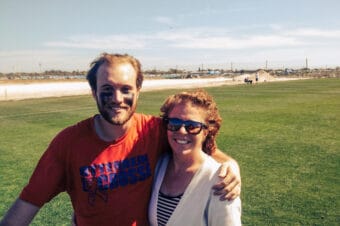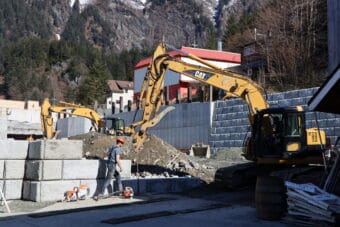
Wildfire smoke is bad for your lungs.
Maybe that’s not news, but seriously, how bad is it? And can you measure that impact and understand it better, say, by looking at the number and type of hospital visits?
That’s what some researchers did with data from Alaska. One of those researchers is Micah Hahn, an assistant professor of environmental health at the Institute for Circumpolar Health Studies at the University of Alaska Anchorage.
Hahn says it might seem obvious that wildfire smoke causes health impacts, but there had actually never been a nuanced, scientific look at those impacts.
LISTEN:
Micah Hahn: Basically, the study allowed us to sort of dive a little bit deeper into the health impacts, to look at it by health conditions — by asthma or by COPD (chronic obstructive pulmonary disease) — and see which particular health impacts were most prevalent. It also allowed us to look by demographic. So we can see which age group was most affected, males or females, what race and geographical area. We compared Anchorage and Fairbanks in the Mat-Su area in this study. So we were trying to get an understanding of how the health impacts looked different in different places in the state.
We also could break it down to look at the number of emergency room visits and timing according to when we saw smoke plumes in the area. So we can sort of see if we see a peak and emergency room visits the same day that there was a lot of air pollution in the air? Or is it two or three days later? And that can help us sort of target when we’re going to need more hands on deck in the emergency room, for example.
Casey Grove: What were all the different data sources that you had to look at? Like how did you put this picture together?
Micah Hahn: What we’re most interested in was the particulate matter — the very small, fine particles less than 2.5 microns. If you stack these particles up, you could put several across one strand of hair, so they’re super tiny. And we’re really most worried about this fine particulate matter because it can get deep into your lungs and even into your bloodstream and really causes the most health impacts. Because those fine particles are a known issue for health, the Environmental Protection Agency requires that cities over a certain size regularly monitor their air quality.
The monitors that are out there measuring air quality, that are run by our Department of Environmental Conservation, measure PM2.5 from all sources. For this study, we were really focused on wildfire smoke, so we combined that information from the on-the-ground air quality monitors with satellite information: pictures that the satellites are grabbing from space to look for smoke plumes, to be able to really identify when we were seeing a peak in particulate matter that was originating from wildfires. So when you had sort of a peak in air pollution and a smoke plume was located in the vicinity, we call that a wildfire day.
Casey Grove: I think I saw there was like that would be a WFD, right?
Micah Hahn: Yeah wildfire day, yeah. Our shorthand so that we didn’t have to write it over and over and over again.
The health information actually came from data that are regularly collected by our Department of Health and Social Services, from all of the hospitalization records that are coming in from hospitals around the state.
Casey Grove: When it was all said and done, was there anything that really stood out to you that surprised you from this?
Micah Hahn: The main finding, I think, is that we really saw the biggest impacts for asthma. So we looked at a number of both respiratory and cardiovascular outcomes, everything from arrhythmia and COPD to asthma, to upper respiratory tract infections. And really, we saw the biggest impact was for asthma-related emergency department visits. This was really across the board and across age groups and in geographic areas.
We also saw an interesting finding in the Matanuska-Susitna area where we at first there was sort of a small decrease in the number of emergency department visits for cardiovascular impacts. But then, a few days after we saw a peak in air pollution, we saw an increase in emergency department visits and in this region. There was basically a little bit of a delay of when people were going to the ER.
One of our thoughts is that the Mat-Su is a little more rural, and it takes a little more time to get to the ER, so many maybe people are like, ‘Man, you know, the smoke is getting bad, but it’s not so bad that I need to make the trip into town to go to the ER.’ So maybe it took a few days for people to be like, ‘Alright, the smoke isn’t going away, it’s really sitting here and I am not feeling well. So I’m going to go in.’
Also maybe people know that it is a hassle to get into town to go to the hospital, maybe have more of a plan in place. If you have asthma, maybe you keep an extra inhaler on hand so that you don’t need to go to the pharmacy in an emergency, or you maybe even have a space in your house that you have a good filter in so that you can really deal with what’s going on outside. I think it kind of speaks to the things that you can be doing in your own personal life to be able to prepare when we have smoke days, especially when it’s a long time.



